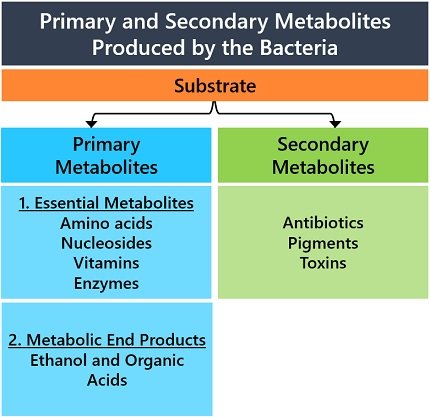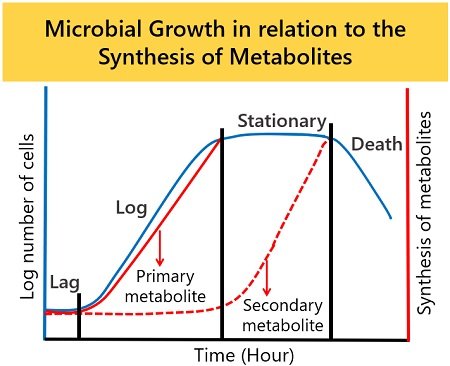The difference between primary and secondary metabolites produced by the bacteria lies in their origin and function. Besides bacteria, different plants and fungi produce a wide range of metabolites.
This post discusses the differences between the bacteria’s primary and secondary metabolites. Also, we will study the comparison chart, definition and examples between the two.
Metabolites can serve as intermediates and end products of metabolism. And metabolism is a combination of anabolic and catabolic reactions.
Primary and secondary metabolites are the two types of metabolic products. Microbes have a tremendous capacity to form various products after consuming different substrates.
Note: Microbes generate metabolites during or at the end of biochemical reactions. In addition, they can produce both high and low molecular weight metabolites.
Origin: Bacteria produce primary metabolites during the log or trophophase. In contrast, bacteria produce secondary metabolites in the stationary or idiophase.
Function: Primary metabolites are necessary for the survival and growth of bacterial cells. In comparison, secondary metabolites are very important in the perspective of industrial applications.
This post also discusses bacterial growth in relation to trophophase and idiophase.
Content: Primary Vs Secondary Metabolites
- Comparison Chart
- Definition
- Types and Examples
- Microbial Growth Vs Primary and Secondary Metabolites Synthesis
- Key Differences
- Conclusion
Comparison Chart
| Properties | Primary Metabolites | Secondary Metabolites |
|---|---|---|
| Alternative names | Central metabolites | Idiolites or Specialized Metabolites |
| Meaning | Primary metabolites are the intermediate compounds that produce first in the metabolic pathway | Secondary metabolites are the end products of the metabolic pathway |
| Phase | It occurs in Trophophase or log phase | It occurs in Idiophase or stationary phase |
| Types of metabolites | Two types (Primary essential metabolites and Primary metabolic end products) | Not classified |
| Type of metabolism | These are the products of primary metabolism | These are the products of secondary metabolism |
| Production quantity | Large | Small |
| Role in bacterial cell growth | Its production is necessary for the survival and growth of bacteria | Its production has no importance in cell growth and development |
| Defensive action | Primary metabolites do not take part in defense actions | Bioactive secondary metabolites have a property of defensive action |
| Production process | Easy | Complex |
| Toxicity | Non-toxic | Toxic |
| Examples | Proteins, enzymes, nucleic acids, carbohydrates, amino acids, vitamins, ethanol etc. | Antibiotics, pigments, toxins etc. |
Definition of Primary Metabolites
Bacteria produce intermediate products during their growth phase that are the primary metabolites. Likewise, plants, fungi and animals also produce primary metabolites during their growth cycle.
Bacteria undergo primary metabolism to form primary metabolites or products. Primary metabolism is nothing but a trophophase or log phase of bacteria.
During trophophase, the bacterial cells go through:
- An exponential increase in the cell number occurs.
- Rapid cell division occurs.
- Cells exhibit high metabolic activity.
- Cell doubling occurs at a constant rate. As a result, bacteria show balanced growth.
- Cells have the optimal concentration of proteins, nucleic acids etc.
Definition of Secondary metabolites
Bacteria produce end products during their stationary phase that are the secondary metabolites. Likewise, plants, fungi and animals also produce such metabolites during secondary growth cycle.
During secondary metabolism, bacteria produce secondary metabolites or products. Secondary metabolism occurs in the idiophase or stationary phase of bacteria.
During idiophase, the bacterial cells go through:
- Cell growth ceases due to nutrient scarcity and the accumulation of toxins.
- Cell proliferation becomes equal to cell death.
- Cells are less metabolically active.
- Spore forming bacteria produce endospores in this phase. At the same phase, some pathogenic bacteria begin to generate toxic substances (virulence factors).
Secondary metabolites are organic compounds that form by the end of log phase. These do not have a direct association with growth, development, and reproduction. Yet, secondary metabolites are necessary for ecological functions.
Types and Examples of Primary Metabolites
Following are the types of primary metabolites:
Primary Essential Metabolites
- Bacteria produce such metabolites in adequate amounts.
- These are important to sustain bacterial cell growth.
- The regulatory mechanisms of bacteria can control their production and overproduction.
- Examples: Enzymes, vitamins, amino acids, Nucleosides etc.
1. Enzymes
- Protease: Bacillus subtilis, Pseudomonas spp, Streptomyces spp etc.
- Cellulase: Bacillus spp
- Amylase: B. subtilis, Streptomyces spp etc.
- Laccase: Pseudomonas aeruginosa, B. subtilis etc.
2. Vitamins
- Riboflavin biosynthesis: Corynebacterium ammonigenes, B. subtilis etc.
- Cyanocobalamin (Vitamin B12): Propionibacterium shermanii, Pseudomonas denitrificans etc.
- Beta carotene (Vitamin A): Erwinia uredovora
3. Amino acids
- L-glutamic acid, L-aspartic acid, L-lysine, L-methionine, L-threonine: Corynebacterium glutamicum, E. coli etc.
Primary Metabolic Endproducts
- These are the end products of bacterial fermentation.
- Primary metabolic endproducts are not important relative to bacterial cell physiology.
- Instead, these are useful for industrial applications.
- Examples: Alcohol and organic acids etc.
1. Alcohol
- Ethanol: E. coli, Klebsiella oxytoca, Clostridium thermocellum etc.
2. Organic acids
- Lactic acid: Lactobacillus spp
- Acetic acid: Acetobacter spp and Gluconobacter spp
- Gluconic acid: Acctinobacillus succinogenes

Examples of Secondary Metabolites
These are not classified into any type. Secondary metabolites include antibiotics, alkaloids, pigments etc.
1. Antibiotics
- 2,4-Diacetylphloroglucinol: Pseudomonas spp
- Phenazine: Pseudomonas spp
- Iturin and fengycin: Bacillus subtilis
- Lipopeptide and polyketide: Bacillus amyloliquefaciens
- PCA (Phenazine-1-Carboxylic acid): P. fluorescens
2. Alkaloids
- Tetrodotoxin: Vibrio spp, Serratia marcescens etc.
- Piperine: Lactobacillus spp, Micrococcus spp etc.
3. Pigments
- Pyocyanin: Pseudomonas aeruginosa
- Violacein: Chromobacterium spp
- Carotenoid: Streptomyces spp
- Anthraquinone: Micromonospora lupinae
- Blue pigment: Vogesella indigofera
Microbial Growth Vs Primary and Secondary Metabolites Synthesis
Here, a graph depicts the cell growth and synthesis of metabolites in relation to time.
- A blue line represents bacterial cell growth.
- A red line indicates the synthesis of metabolites by bacteria.

If you look into the log number of cells Vs time, there are four phases. Lag, log, stationary and death phases represent the different stages of bacterial growth.
1. Lag phase
Cells exhibit cellular activity. But, cell growth does not occur. The bacterial cells may show a slight increase in size. However, no cell division occurs during this phase.
Note: The acceleration phase is a short transition phase. It occurs between the lag phase and log phase. During this phase, cells tend to grow slowly.
2. Exponential (Log) Phase
Cells undergo cell division through binary fission. As a result, cell doubling occurs after each generation time. At the same time, metabolic activity is very high.
Note: The deceleration phase is short-lived. It occurs after the cell growth in the log phase decreases.
3. Stationary Phase
Bacterial cell growth reaches a plateau. The viable cell population becomes equal to the dead cell population. As a result, the net population growth becomes equal to zero.
Due to nutrient scarcity, competition for nutrients increases. Thereby, the bacterial cells show less metabolic activity.
4. Death Phase
Here, the cells acquire accumulated wastes of the medium. Later, an exponential increase in the number of dead cells occurs. In addition, population growth experiences a sharp decline.
Curve representing primary metabolites synthesis:
- A red curve rises from the end of the lag phase to the beginning of the stationary phase.
Curve representing primary metabolites synthesis:
- A red dotted curve rises from the end of the log phase to the beginning of the death phase.
Points to Remember
- Bacteria in the log phase exhibit highest metabolic activity and produce central metabolites. During the trophophase, bacteria show a logarithmic increase in their cell mass increases. But, as the resources become limiting, the growth rate drops and production stops.
- Bacterial growth in the stationary phase becomes stagnant and produce secondary metabolites. Spore forming bacteria produce endospores in this phase. In addition, some pathogenic bacteria form virulence factors. The former helps them to withstand adverse conditions. In contrast, the latter allows them to cause disease or infection.
Key Differences Between Primary and Secondary Metabolites
- Production of primary metabolites occurs first in the bacterial growth cycle. And they function as intermediate compounds. Whereas the production of secondary metabolites occurs after the synthesis of primary metabolites. And, these serve as the end products of the metabolism.
- Bacteria in the trophophase or log phase produce primary metabolites. Whereas, they produce secondary metabolites during the idiophase or stationary phase.
- Primary essential metabolites and fermentable end products are two types of primary metabolites. Whereas secondary metabolites are not classified into any types.
- Production of primary metabolites occurs as the result of primary metabolism. On the contrary, the production of secondary metabolites takes place during secondary metabolism.
- Bacteria produce central metabolites in adequate quantities. In contrast, bacteria produce Idiolites in small quantities.
- Primary metabolites production is necessary for the survival and growth of bacteria. While bioactive secondary metabolites serve as antimicrobial agents, antiparasitic agents, enzyme inhibitors etc.
Conclusion
Bacteria and other microbes have broad applicability in pharmaceutical, food, textile, agricultural industries. Unlike chemical synthesis, microbial fermentation reduces the cost of product formation. Biofermentation uses microbes to produce various valuable products through adequate supply of substrates.